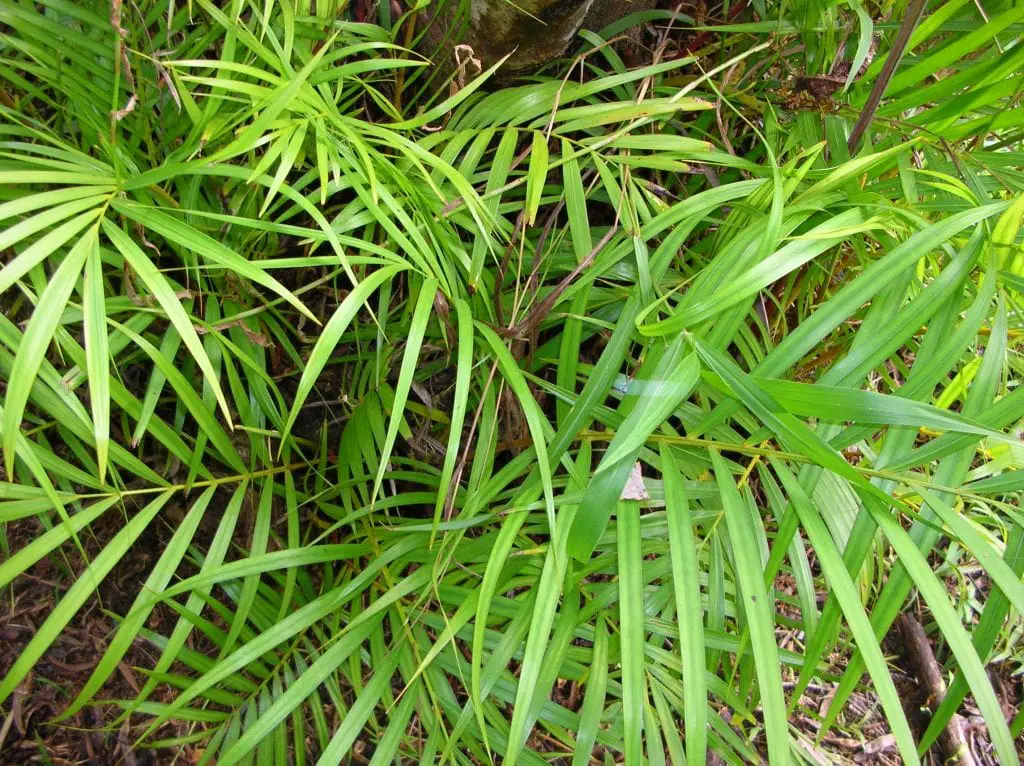
Image – Wikimedia Commons / Forest & Kim Starr
Some species of palm trees develop stems from the root system of the ‘main or mother plant’, which can then be divided and thus obtained several plants from one. Of these plants that we are seeing, the best known are the following: the palm heart, rapis and the fishtail palm.
It is not easy to be successful separating the suckers from the palm trees, since being herbaceous plants (giant, but herbaceous after all 🙂) they do not have as much capacity to emit new roots as many trees and shrubs do.
What species of palm trees produce suckers?
The palm trees that interest us are those that are multi-stemmed, that is, they produce several trunks, and which also do so from the root. That is, we may be interested in, for example, the following:
mild caryota

Image – Wikimedia Commons / Forest & Kim Starr
It is a palm native to Southeast Asia that reaches a height of up to 10 meters known as the fishtail palm or branched fishtail palm. Its leaves are bipinnate and form a very dense crown, something that makes it a species of great beauty for tropical and subtropical gardens. It does not resist frost.

Related article:
How do you care for the Fishtail Palm?
Chamaerops humilis

This is one of the few autochthonous species of Spain, and specifically of the Mediterranean Region. Reaches a maximum height of 3 metersand develops fan-shaped, rigid and green or bluish leaves depending on the variety. Resists up to -10ºC.

Related article:
Palmito, Chamaerops humilis
Deeply shining

Image – Wikimedia Commons / Jon Colbert
Known as areca (not to be confused with the genus of palm trees Areca), yellow palm or bamboo palm, is a beautiful multicaule species native to Madagascar that reaches a maximum height of 9 meters, although it does not usually exceed 3m. The leaves are pinnate, green or light green in color, and it is perfect for places with a tropical and warm temperate climate. From experience I can tell you that it resists weak and specific frosts of up to -2ºC if it is sheltered.

Related article:
Areca (Dypsis lutescens)
Phoenix dactylifera

It is one of the most important commercial plants in the world, as it produces fruits, dates, which are in great demand. It is known as the date palm, date palm, or phoenix, and is native to North Africa and West Asia. It can reach a maximum height of 30 meterswith a thin trunk crowned by pinnate leaves of a magnificent bluish-green color. It is capable of resisting up to -10ºC if there are occasional frosts, but prefers that it does not fall below -4ºC.

Related article:
high vines

image – Wikimedia Commons / David J. Stang
It receives the common names of Chinese palm, bamboo palm and rapis, and is a species native to China that reaches a height of 4 meters. Its leaves are webbed, and dark green. It is highly recommended for gardens without frost, although it can hold up to -2ºC if it is for a short time.

Related article:
high vines
When and how is the division of suckers in palm trees carried out?
The division of suckers can be done from May to July if you live in the Northern Hemisphereand if you live in the southern hemisphere, it can be carried out from November to January, that is, during late spring and early summer.
But how do you carry out these types of division by suckers? To perform this division, with a hoe, you are going to dig around the sucker that you want to separate some trenches with a depth of at least 30 centimeters, and then with a hand saw previously disinfected with pharmacy alcohol you will separate themplanting each of the portions in an individual pot with a substrate that has good drainage, such as universal substrate (for sale here!) with perlite (for sale here!) at 50%. Remember that each part must have the greatest amount of soil attached to the root.
It is very important that the waterings you give to your new plants are very frequent until the roots take hold and develop new roots.
Remember that a very common mistake that people tend to make when doing this type of division is to place the plants in the sun after they have been separated. I recommend that you put them in the shade or at least half shade for several weeks so they have enough time to overcome post-transplant stress. In addition, it is highly advisable to water with rooting hormones (for sale here!) to stimulate the production of new roots, something that will give strength to the plants. You pour a small spoonful in 1l of water, and water.
When can I plant them in the garden?

Image – Wikimedia Commons / Wikipedia, the free encyclopedia // Chamaedorea cataractarum
I do not want to disappoint you, but the truth is that getting palm tree suckers to prosper once they have been separated from the mother plant, although it is not impossible, it is complicated. You have to control the irrigation a lot, avoid that the earth dries up but also that it floods; It is even highly advisable to spray its leaves from time to time with rainwater or lime-free so that they do not dehydrate.
Once you see growth, leave them in those pots for a year, at least. You can plant them in the ground when you see roots coming out of the drainage holes.
I hope you are very lucky 🙂.
If you want to know how to multiply palm trees by seeds, don’t miss this article:

Related article:
Palm tree reproduction: seeds

